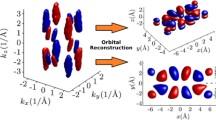Abstract
Interpretation of experiments involving use of vacuum ultraviolet radiation to effect ionization of N2 in terms of measurements of a molecular orbital is erroneous.
Similar content being viewed by others
References
Itatani, J., Levesque, J., Niikura, H., Pepin, H., Kleffer, J.C., Corkum, P., Villeneuve, D.M.: Tomographic imaging of molecular orbitals. Nature. 432, 867–871 (2004)
Pauling, L.C., Wilson, E.B.: Introduction to Quantum Mechanics. McGraw-Hill, New York (1935)
Ortiz, J.V.: Ground and excited states of CaCH3, CaNH2, CaOH and CaF through calculations of electron propagators. J. Chem. Phys. 92, 6728–6731 (1990)
Koopmans, T.: The classification of wave functions and eigenvalues to the single electrons of atoms. Physica. 1, 104–113 (1934)
Cederbaum, L.S., Hohlneicher, G., von Niessen, W.: Breakdown of Koopmans’ theorem for dinitrogen. Chem. Phys. Lett. 18, 503–508 (1973)
Pauling, L.C.: The Nature of the Chemical Bond, 3rd edn. Cornell University Press, Ithaca (1960)
Schwarz, W.H.E.: Measuring orbitals—provocation or reality? Angew. Chem. Int. Ed. 45, 1508–1517 (2006) references therein
Ogilvie, J.F.: The nature of the chemical bond 1990—there are no such things as orbitals. J. Chem. Ed. 67, 280–289 (1990)
Zuo, J.M., Kim, M., O’Keeffe, M., Spence, J.C.H.: Direct observation of d-orbital holes and Cu-Cu bonding in Cu2O. Nature. 401, 49–52 (1999)
Wang, S.G., Schwarz, W.H.E.: On closed-shell interactions, polar covalences, d-shell holes and direct images of orbitals—the case of cuprite. Angew. Chem. Int. Ed. 39, 3794–3796 (2000)
Scerri, E.R.: Have orbitals really been observed? J. Chem. Ed. 77, 1491–1494 (2000)
Jayatilaka, D.: A wave function for Be from xray diffraction data, chapter 21. In: Mezey, P.G., Robertson, B.E. (eds.) Electron, Spin and Momentum Densities and Chemical Reactivity, pp. 253–263. Kluwer, Dordrecht Netherlands (2000)
Rousseau, D.L.: Case studies in pathological science. Amer. Sci. 80, 54–63 (1992)
Acknowledgments
I thank Dr. H. J. Aa. Jensen and Professors W. H. E. Schwarz and A. J. Stone for helpful discussion.
Author information
Authors and Affiliations
Corresponding author
Rights and permissions
About this article
Cite this article
Ogilvie, J.F. Is a molecular orbital measurable by means of tomographic imaging?. Found Chem 13, 87–91 (2011). https://doi.org/10.1007/s10698-011-9113-1
Published:
Issue Date:
DOI: https://doi.org/10.1007/s10698-011-9113-1




